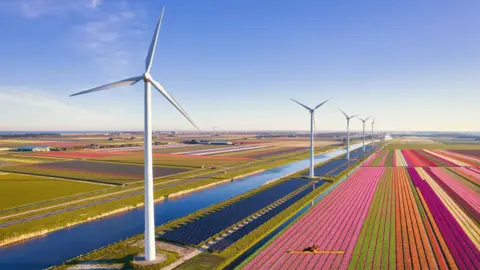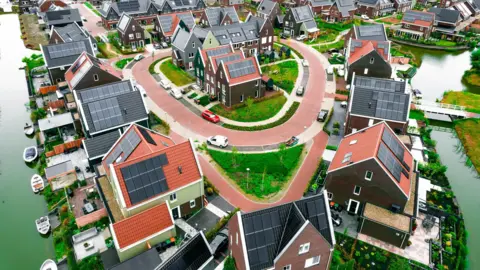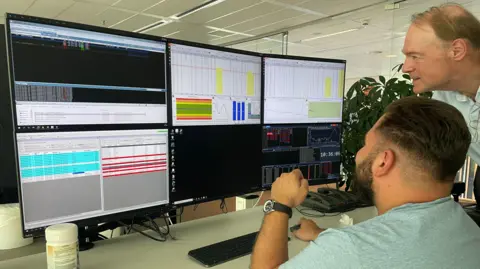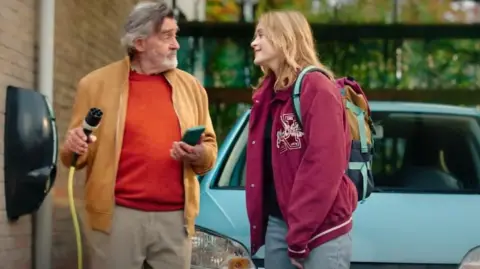Renewable energy dynamics in the Netherlands are putting pressure on its electricity network

John LaurensonEconomic journalist, Rotterdam
 AFP via Getty Images
AFP via Getty ImagesIn a Dutch government television campaign called “Flip the Switch”, an actress warns viewers about their electricity consumption.
“When we all use electricity at the same time, our power grid is overloaded,” she says. “This can cause malfunctions. So use as little electricity as possible between four and nine hours.”
It’s a sign that, in one of the world’s most advanced economies, something is wrong with the country’s electricity supply.
The Netherlands has enthusiastically adopted electric cars. It has the highest number of charging stations per capita in Europe.
As for electricity production, the Netherlands has replaced gas from its vast North Sea reserves with wind and solar.
So much so that it leads in Europe for the number of solar panels per person. In fact, more than a third of Dutch homes are equipped with solar panels.
The country also aims to make offshore wind farms its main source of energy by 2030.
This is all a good thing from an environmental point of view, but it puts the Dutch national electricity grid under enormous pressure and in recent years there have been several power outages.
The problem is “grid congestion,” says Kees-Jan Rameau, chief executive of Dutch energy producer and supplier Eneco, where 70% of its electricity production is now solar and wind.
“Grid congestion is like a traffic jam on the power grid. It is caused by either too much power demand in a certain area or too much power being supplied to the grid beyond what the grid can handle.”
He says the problem is that the grid “was designed at a time when we had just a few very large power plants, mostly gas-fired.”
“So we built a network with very large power lines near these power plants, and smaller and smaller power lines as you go towards the households.
“Today we are moving to renewable energy, which means that a large amount of electricity is fed into the grid at the edge of the grid, where there are only relatively small power lines.”
And these small power lines are struggling to keep up with all the electricity coming from wind turbines and solar panels scattered across the country.
 AFP via Getty Images
AFP via Getty ImagesDamien Ernst, professor of electrical engineering at the University of Liège in Belgium, is one of Europe’s leading experts on electrical networks. According to him, this is a costly problem for the Netherlands to solve.
“They have a grid crisis because they haven’t invested enough in their distribution networks, in their transmission networks, so they’re facing bottlenecks everywhere, and it’s going to take years and billions of dollars to solve this problem.”
Professor Ernst adds that this is a European-wide problem. “We have a huge amount of solar panels being installed, and they are being installed at far too high a rate for the grid to accommodate them.”
At Eneco’s headquarters in Rotterdam, Mr. Kees-Jan Rameau shows off a large control panel that the company calls its “virtual power plant” and “the brain of our operations.” It is used to help balance the network, preventing power outages.
When electricity production is too high in the Netherlands, Eneco can turn off wind turbines and turn off solar panels.
As for electricity demand that is too high, it reduces power for customers who have accepted that Eneco stops or reduces their electricity supply when the network is under tension in exchange for lower prices.
But for homes and businesses wanting to increase their electricity consumption with a new or wider grid connection, this is increasingly not possible.
“Often consumers want to install a heat pump or charge their electric vehicle at home, but this requires a much larger electrical connection and they simply cannot get it,” explains Mr. Kees-Jan Rameau.
He adds that it is worse for businesses. “Often they want to expand their operations and simply cannot obtain additional capacity from grid operators.
And we have reached the point where even building new housing in the Netherlands is becoming more and more difficult, because there is simply no capacity to connect these new neighborhoods to the grid. »
These people and businesses find themselves on waiting lists for several years. At the same time, there are also waiting lists for those who want to feed electricity into the grid, such as a new house with solar panels on the roof.

Tennet, the government agency that manages the Netherlands’ national grid, says 8,000 companies are currently waiting to be able to supply electricity, while another 12,000 are waiting for permission to consume more electricity.
Some sectors of the Dutch economy warn that this is hampering their growth. “Network congestion endangers the future of the Dutch chemical industry… while in other countries it will be easier to invest,” says Nienke Homan, president of the Dutch Chemical Association.
So was this all avoidable? “Looking back, I think almost all problems can be avoided,” says Mr. Kees-Jan Rameau.
He adds that following the 2015 Paris Agreement on tackling climate change, “we focused heavily on increasing renewable energy production. But we sort of underestimated the impact that would have on the power grid.”
Tennet now plans to spend 200 billion euros ($235 billion; £174 billion) to strengthen the network, including laying some 100,000 km (62,000 miles) of new cables by 2050.
This is a huge amount of money, but not spending it also comes at a high cost. Network congestion costs the Dutch economy up to €35 billion a year, according to a 2024 report from management consultancy Boston Consulting Group.
Eugene Baijings, head of network congestion at Tennet, says patience is unfortunately required. “To strengthen the network, we must double, triple, sometimes tenfold the capacity of the existing network.
“And it takes on average about 10 years to complete a project like that before it goes live, the first eight of which are the legislation and getting the rights to install cables in the ground with all the owners. And only the last two years are the construction period.
“And meanwhile, the energy transition is going so fast that we cannot cope with it, with the existing grid. So any additional demand [to connect] added to the waiting list.
 Also turn the switch
Also turn the switchAt the Dutch Ministry of Energy, which is actually called the Ministry of Climate Policy and Green Growth, Minister Sophie Hermans was not available for an interview. But his office issued a statement:
“Looking back, the speed at which our electricity consumption has grown may have been collectively underestimated in the past by all parties involved. It is also difficult to predict where growth will occur first, as it depends on individual companies/sectors and households.”
As for solutions, the ministry says it has a “National Action Plan Against Network Congestion” focused on adjusting legislation so that network expansion permits can be granted more quickly.
It encourages people to make better use of the existing network with, for example, its Flip the Switch campaign.
And the financial incentive for those who feed their surplus solar electricity into the grid is reduced to almost nothing. In some cases, people will even have to pay to feed solar energy into the grid.





